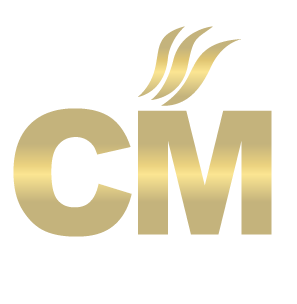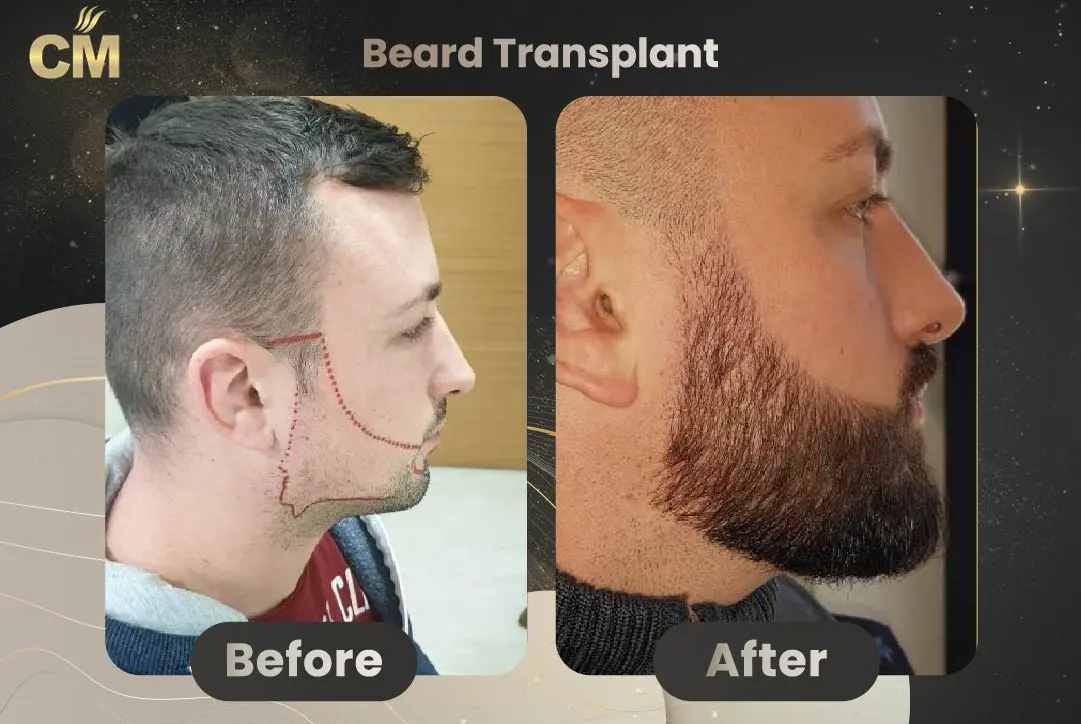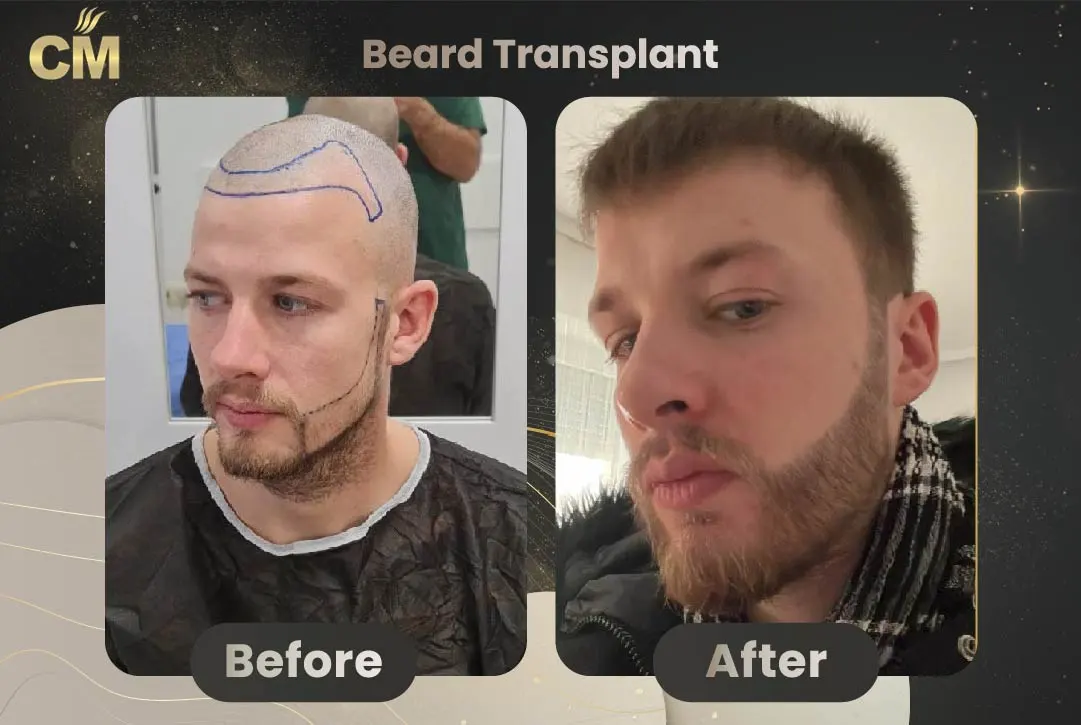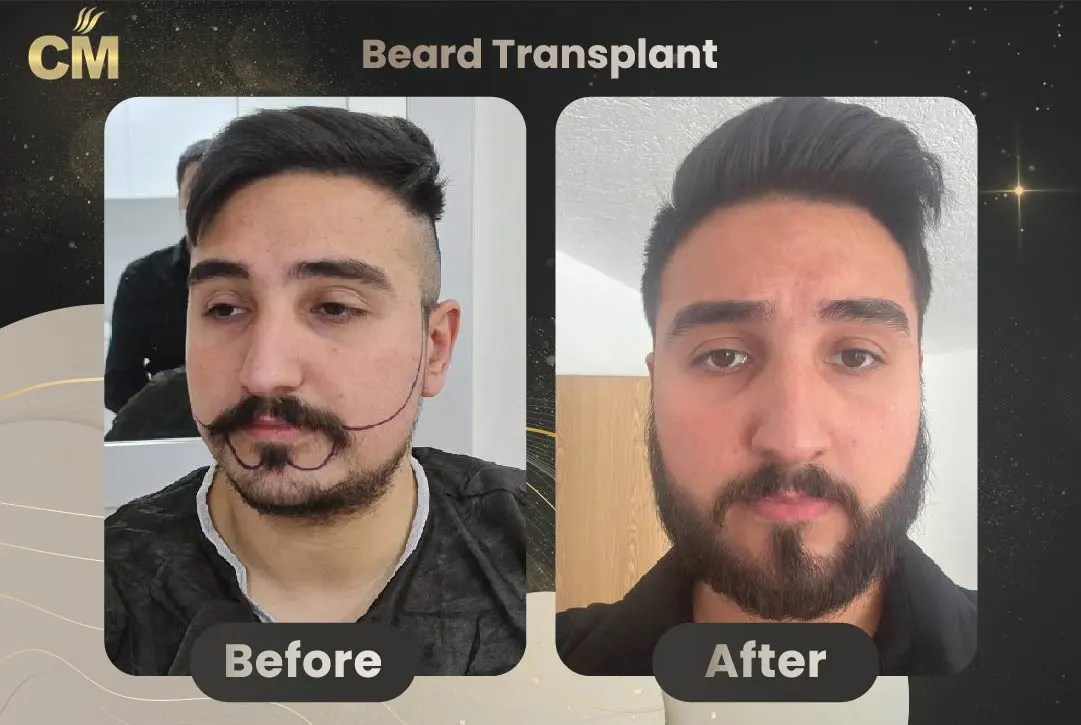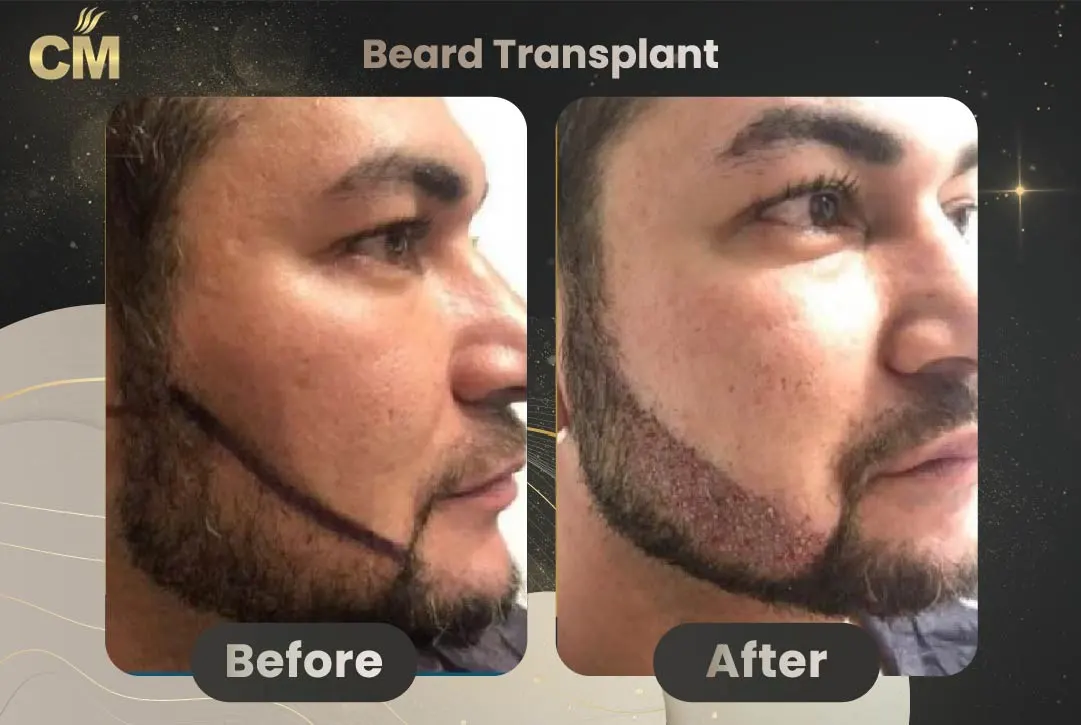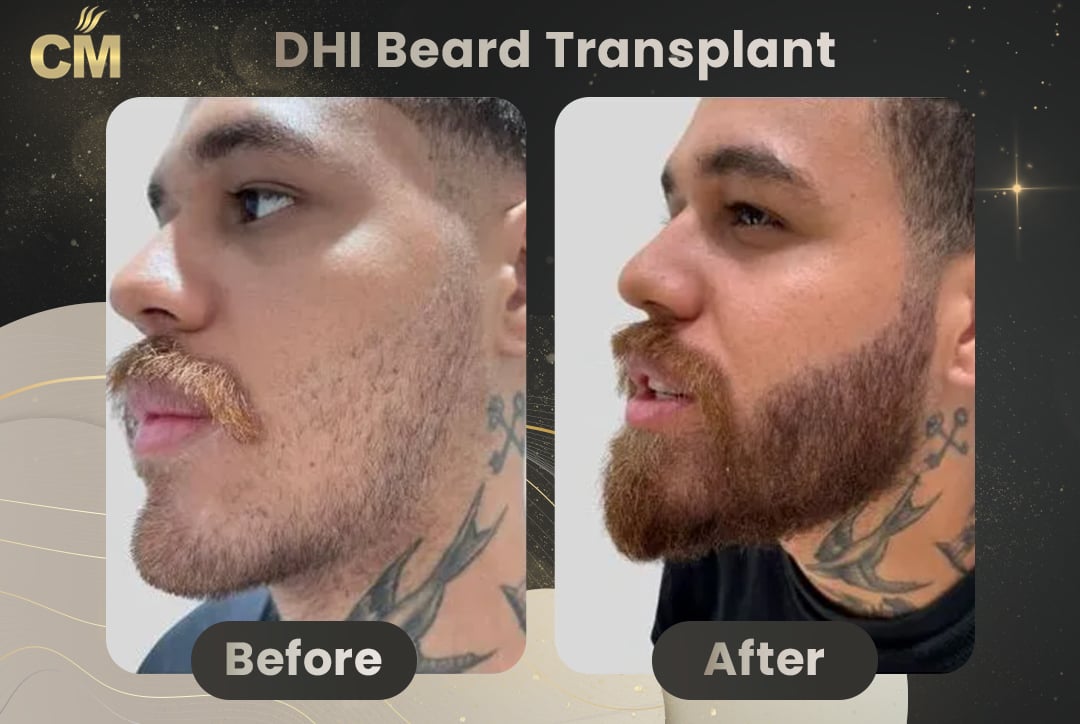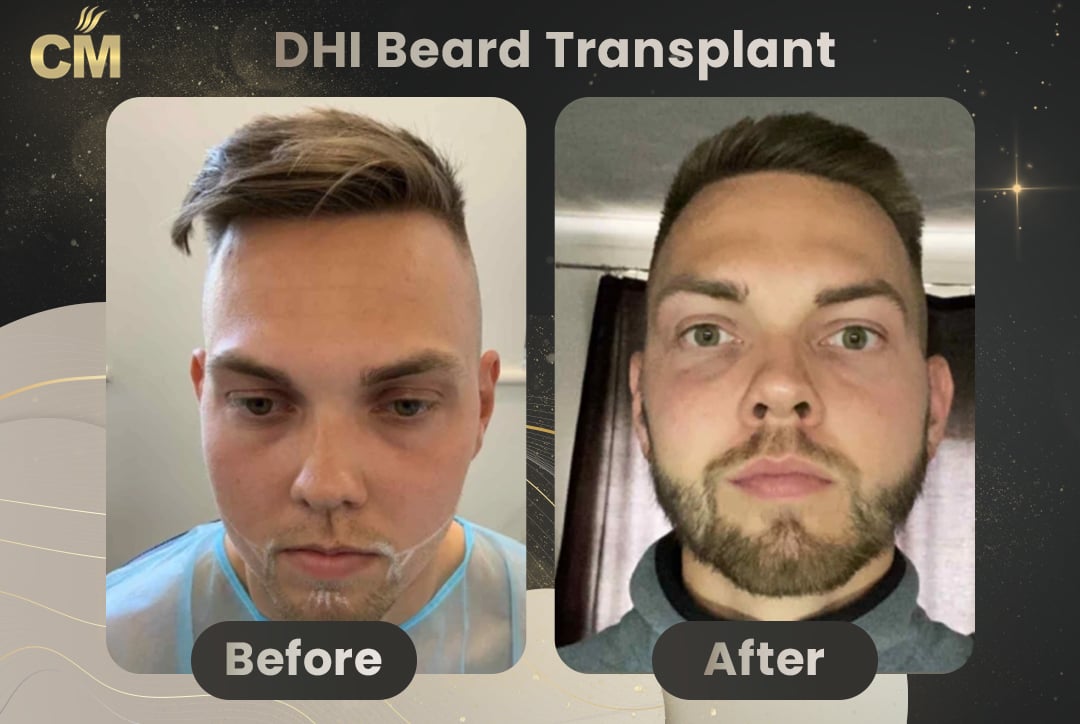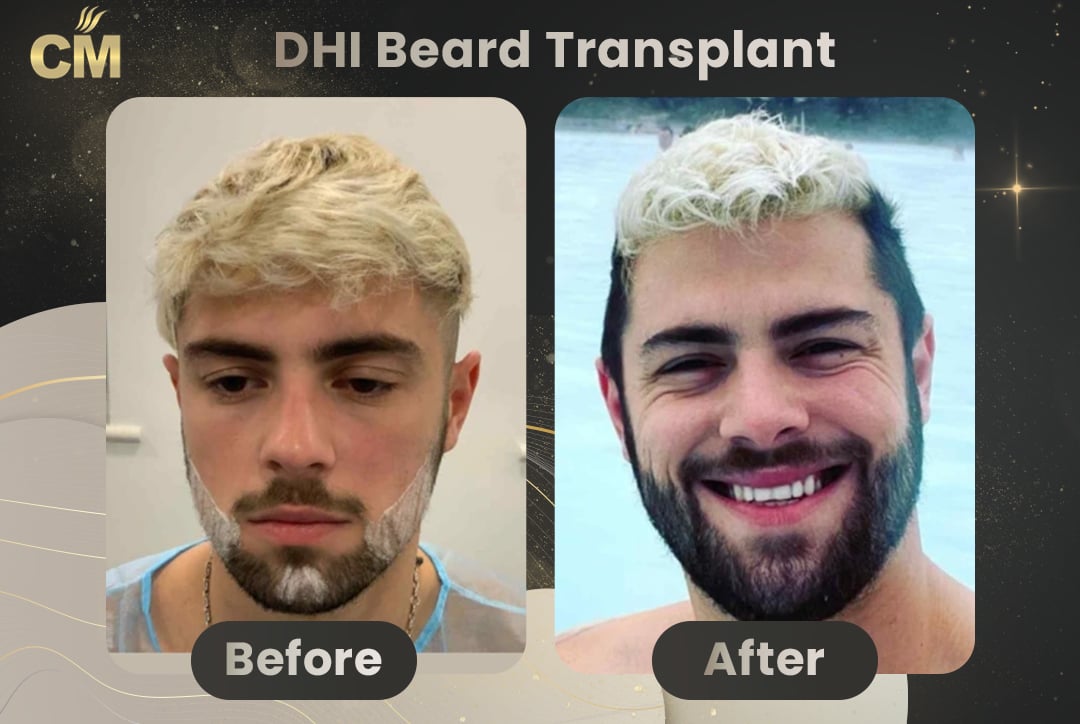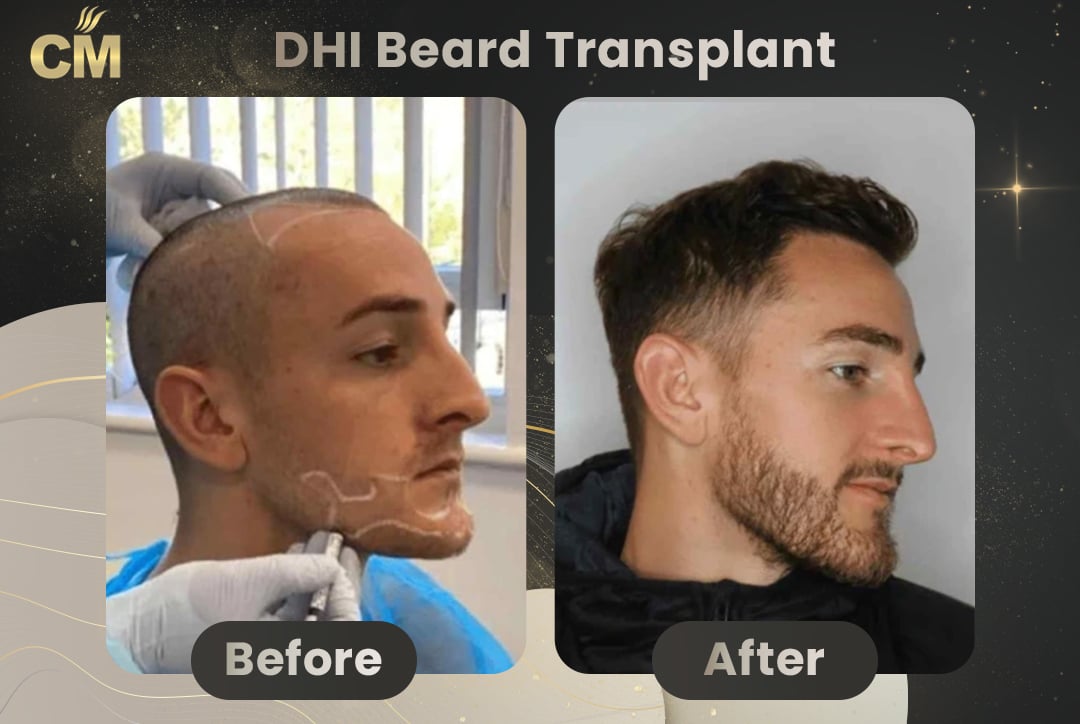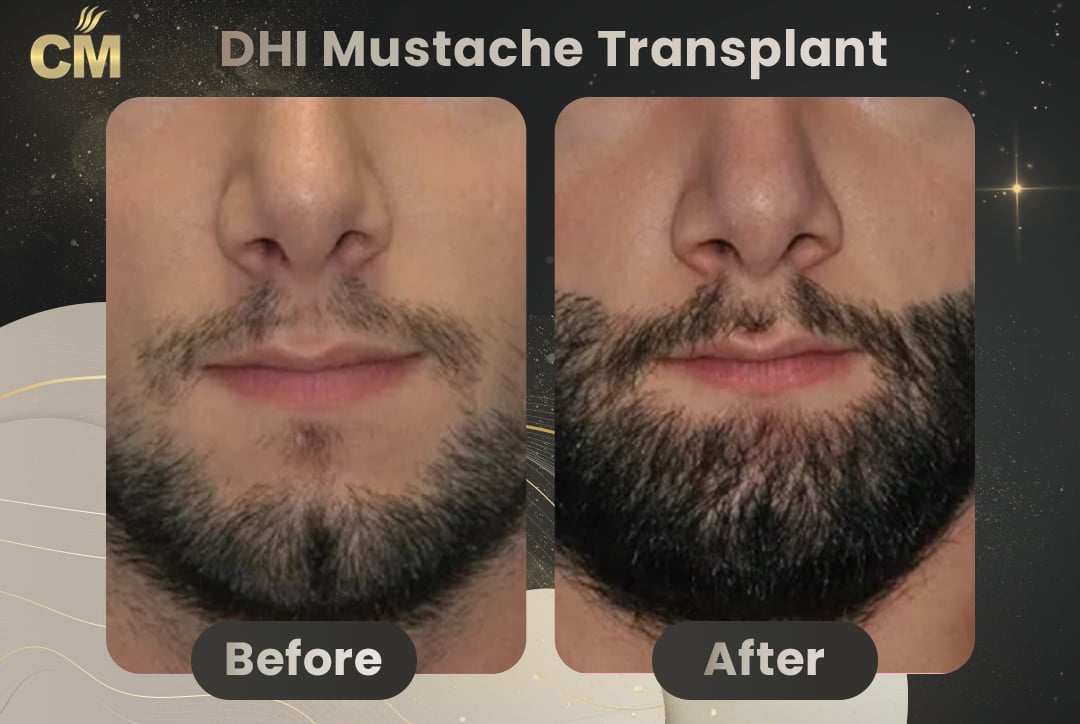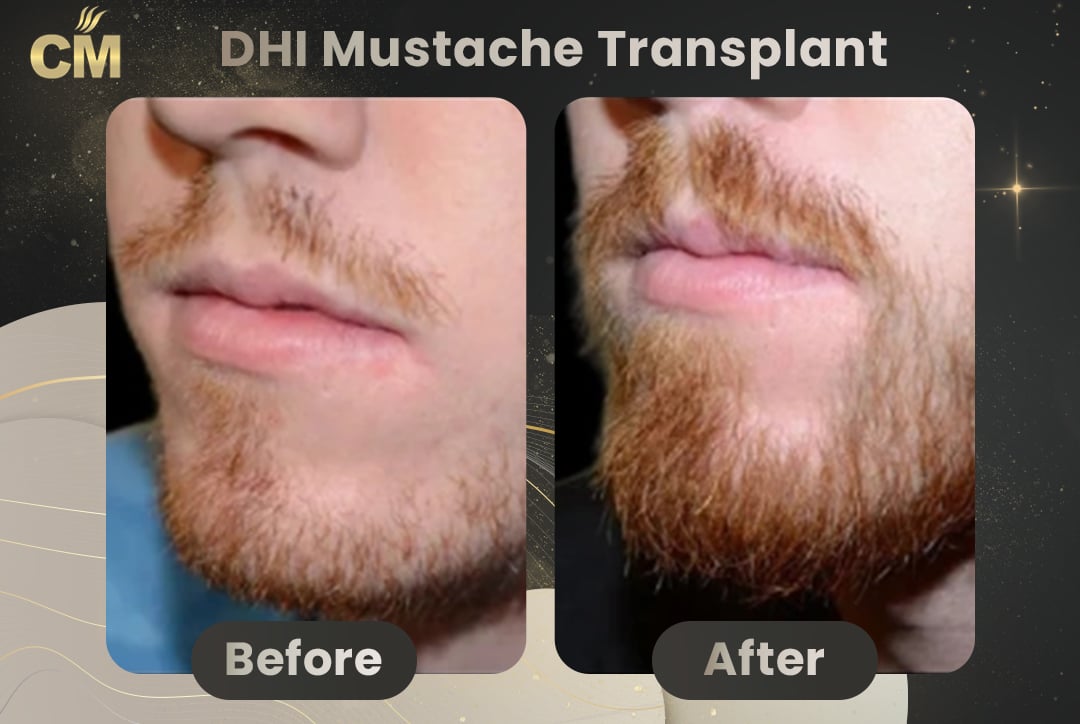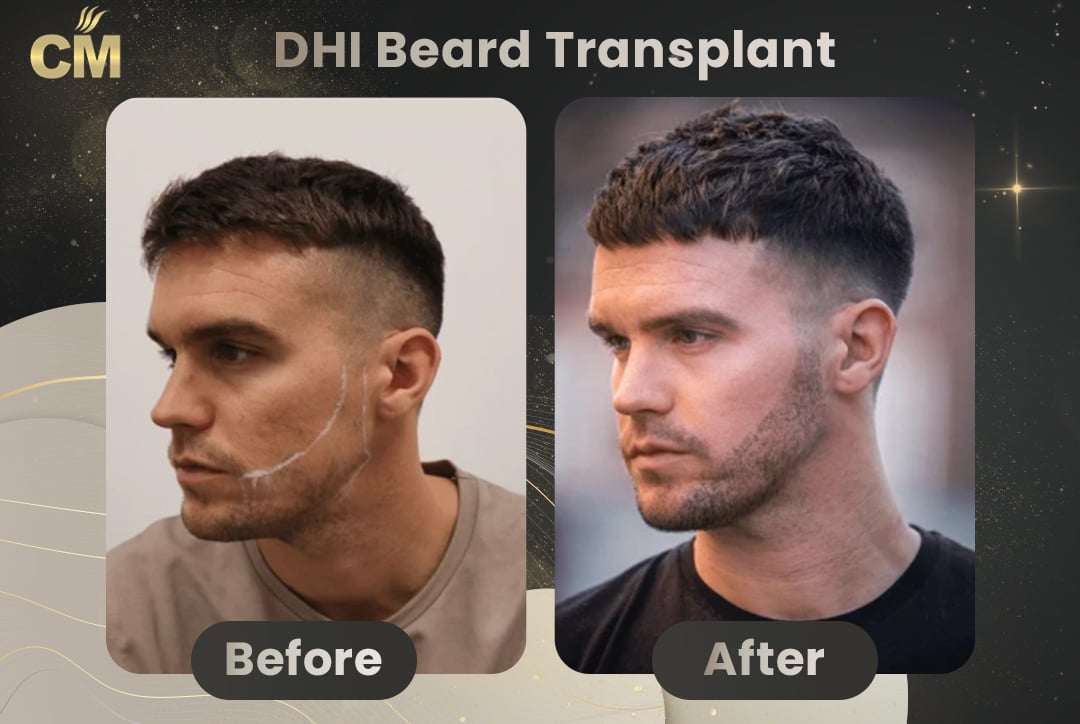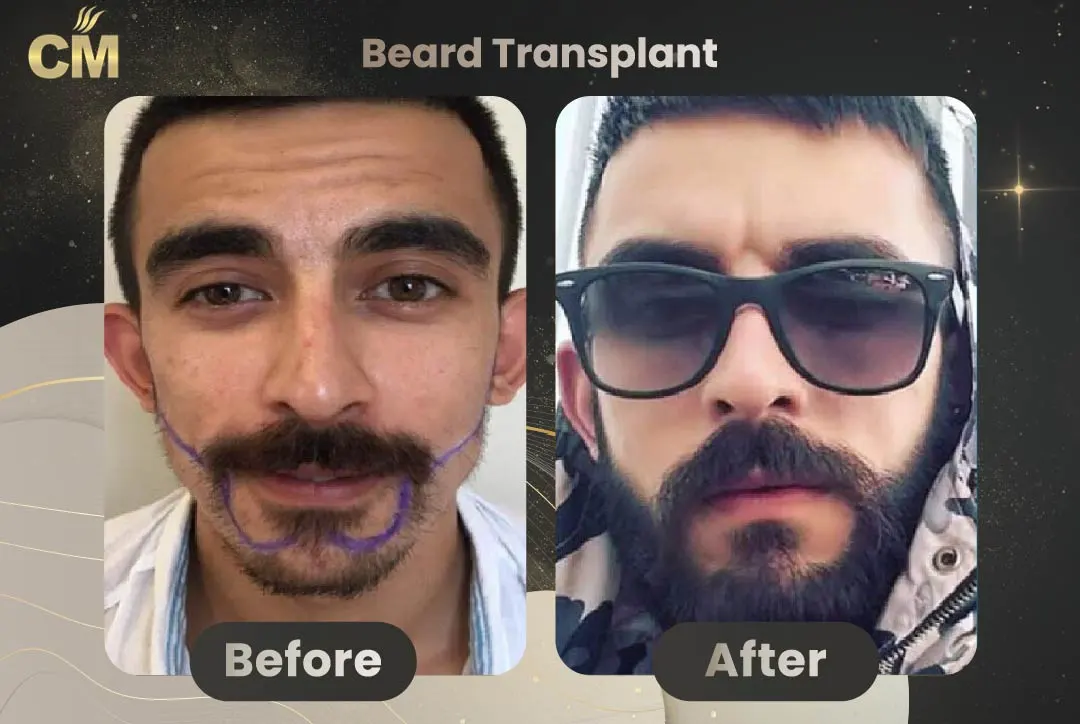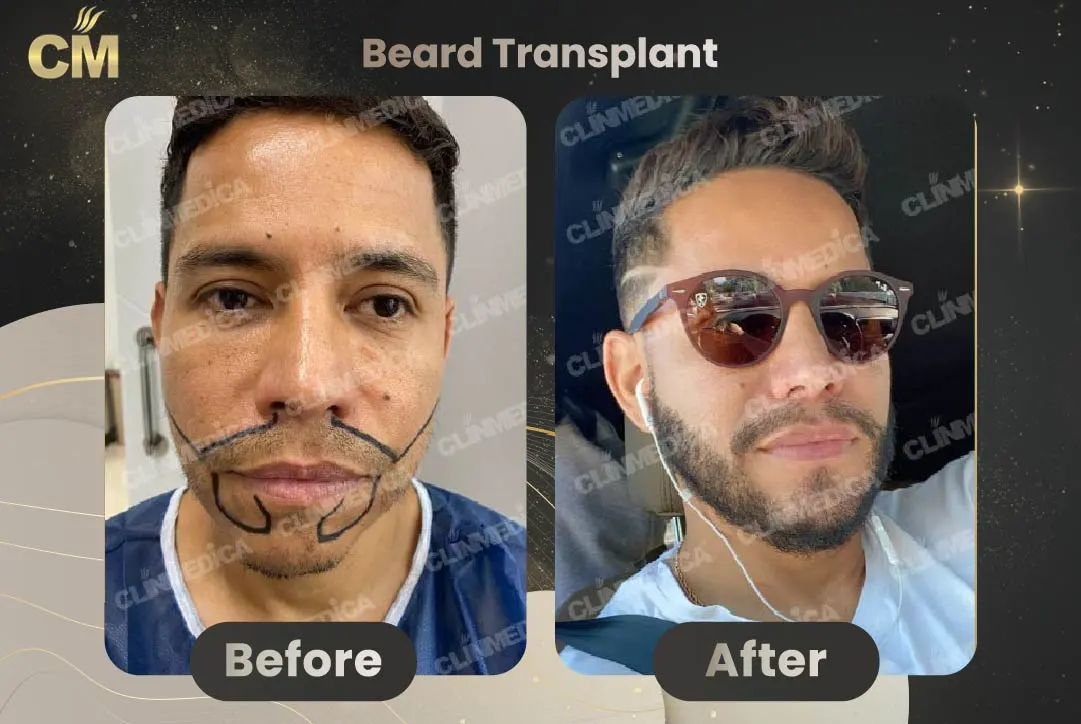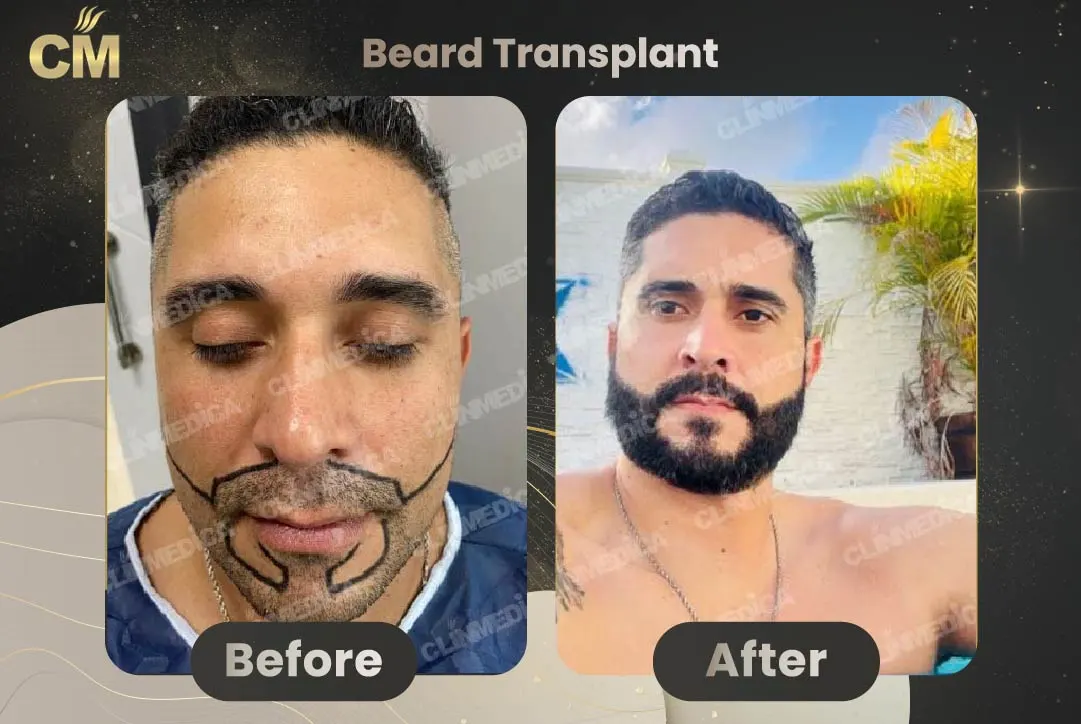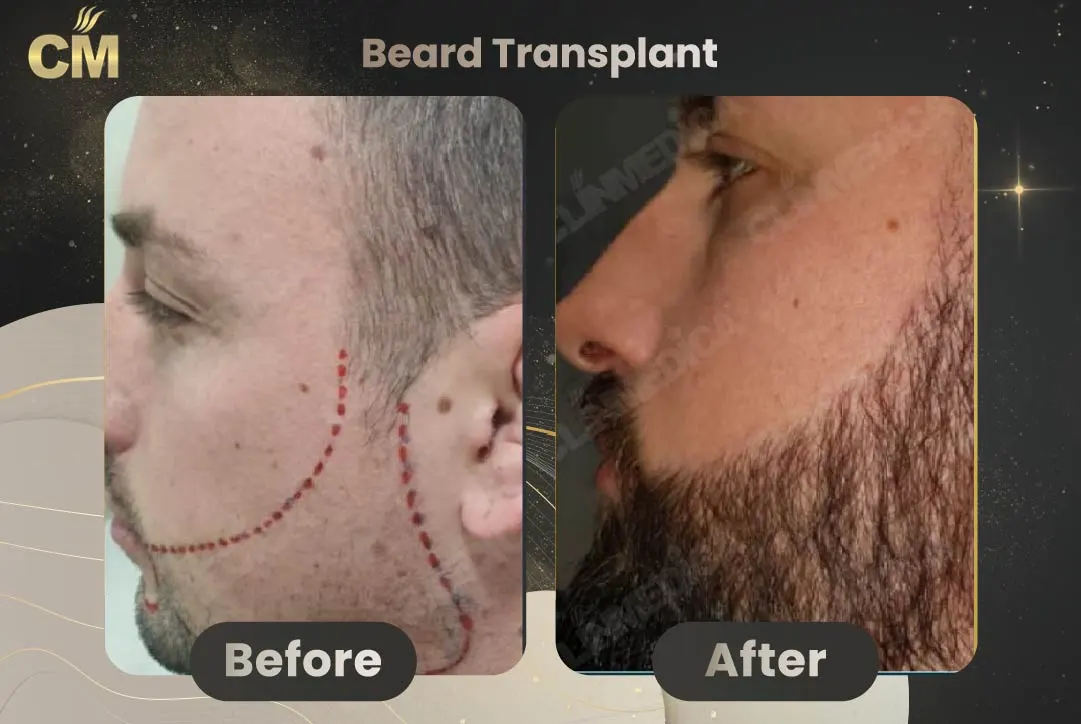Beard Transplant Before and After in Turkey – Instructions and Photos
Facial hair has long been a symbol of masculinity, wisdom, and confidence. However, not every man is genetically blessed with a full and even beard. Conditions such as facial alopecia or inherited hair loss can result in patchy or sparse facial hair. Fortunately, beard transplant procedures offer a lasting solution. In particular, the beard transplant in Turkey has gained global recognition for its quality, affordability, and impressive patient satisfaction rates.
Turkey has become a central hub for medical tourism, especially in the field of facial hair transplant surgery. From beard hair transplant to beard implants turkey, thousands of individuals travel each year to undergo safe, advanced procedures that offer transformative beard transplant before and after results.
In this article, we’ll explore the full process, showcase beard transplant before and after pictures, and guide you through everything you need to know-from technique to pricing and aftercare.
Personalized Beard Transplant Services in Turkey
Whether you’re aiming for a rugged stubble, a sharp mustache, or a full, well-defined beard, modern clinics in Turkey provide personalized beard hair transplant solutions. Each procedure is carefully designed to suit the individual’s facial structure, hair texture, and aesthetic goals.
Our approach to facial hair transplant ensures a natural appearance by controlling the direction, angle, and density of implanted hairs. The outcome? A beard that blends seamlessly with your existing facial hair — boosting confidence and facial symmetry.
Say goodbye to uneven growth and hello to realistic, lasting results. This transformation is evident in before after hair transplant photos that speak for themselves.
Beard Transplant Techniques Used in Turkey
Clinics in Turkey typically perform beard transplants using two main implantation methods: the Sapphire Pen and Direct Hair Implantation (DHI), both widely used in modern hair transplantation before after procedures. However, the extraction of grafts is always performed using the Follicular Unit Extraction (FUE) technique.
In this process, grafts are harvested from the donor area, commonly located at the back of the scalp, particularly behind the ears. The number of grafts used can vary, but a standard beard hair transplant before and after case may require between 1500 and 4000 grafts, depending on the density desired and the size of the beard area to be filled.
The use of FUE ensures minimal scarring, faster healing, and precise follicle extraction, making it one of the safest and most effective methods available. Whether you’re undergoing a beard to scalp hair transplant before and after case or a standard facial procedure, these techniques ensure results that look and feel natural.
Who Is Not a Suitable Candidate for a Facial Hair Transplant?
Although a beard transplant is considered a minimally invasive and relatively safe procedure, it is not suitable for everyone. Certain health conditions or anatomical limitations may affect your eligibility for surgery. Patients with the following issues may not be ideal candidates for facial hair transplant surgery:
-
Cardiovascular diseases
-
Uncontrolled diabetes
-
Blood-borne infections such as HIV or hepatitis C
-
Insufficient donor area on the back of the scalp
Additionally, individuals with unrealistic expectations or active skin disorders in the beard area should consult with a specialist before proceeding. Clinics in Turkey are known for offering comprehensive consultations before treatment to evaluate candidacy and ensure patient safety.
Side Effects of Beard Transplant in Turkey
Like any medical procedure, beard transplant Turkey may have temporary side effects. However, they are generally mild and manageable with proper post-operative care. Common side effects include:
-
Shock Loss: In the first few weeks, some transplanted hairs may fall out. This is a normal phase, and new hair will grow from the implanted roots.
-
Itching and Swelling: You may experience minor itching, swelling, or discomfort in both the donor and transplanted areas.
-
Scarring: When using advanced methods like DHI or the Sapphire Pen, scarring is usually minimal and heals within a few weeks.
Patients can typically return to normal activities within days after the procedure. These temporary side effects are outweighed by the long-term benefits, as seen in beard transplant before and after pictures and hair implants before and after pics.
How Is the Beard Transplant Performed?
The beard transplant procedure begins with the preparation of the donor area, typically located at the nape or behind the ears. Local anesthesia is applied to ensure a painless experience. Using the FUE technique, our surgeons extract grafts with precision tools like perforated micromotors.
Once extracted, the grafts are stored in a sterile solution at a controlled temperature. Depending on the size of the area to be covered, the required number of grafts usually ranges from 1500 to 4000, similar to cases such as 2000 hair grafts before and after and 3500 grafts hair transplant before and after.
Placement of the grafts into the beard is done with extreme accuracy to mimic natural beard growth. Our surgeons pay special attention to the angle and direction of hair to ensure a seamless, natural look.
In beard transplant cost turkey cases, the number of grafts is one of the key factors in determining the final cost.
Is It Possible to Randomly Transplant Grafts into the Beard?
During a beard hair transplant, not all grafts are identical. Some grafts contain a single hair, while others may have two, three, or even more hairs. For natural-looking results, especially in the beard hairline, only single-hair grafts should be placed in the front.
Multi-hair grafts are used progressively toward the lower beard regions, including the cheeks and chin. This technique creates a gradual density that mimics natural beard growth, just as seen in beard transplant before after cases.
In patients who undergo beard to scalp hair transplant before and after procedures, similar principles apply—preserving natural appearance by matching graft type to facial region.
Such precision ensures that results reflect authentic, masculine hair patterns, particularly in beard implants turkey procedures.
Can You Grow a Beard on the Lower Neck?
In some cases, patients ask if it’s possible to extend the facial hair transplant to the lower neck. Technically, it is possible, but it requires extreme precision. The neck skin is thinner and more sensitive than other parts of the face, making facial hair transplant surgery in this area more complex.
In beard transplant turkey procedures, grafts can be placed up to 3–4 cm below the chin, but not on the neck itself. This is due to the difficulty in opening channels in such a sensitive area. Attempting to place beard hair implants in the neck may lead to inconsistent results or complications.
Therefore, while the beard can be extended slightly lower than the palate, full coverage of the neck is not recommended. Experienced surgeons always assess the skin’s condition to determine how far the hairline surgery can go without compromising safety or aesthetics.
Beard Transplant Post-Treatment Care
Proper post-treatment care is crucial for optimal healing and results. we provide yours our patients experience guide helps Patients should expect:
- Reddish appearance disappearing within 1-2 weeks
- First wash after 24-48 hours
- Visible beard appearance forming within 2-3 days
- First shave recommended after at least one month
- Potential shock loss 2-4 months post-operation
- Full regrowth and final results within 9-12 months
Post-Procedure Care for Long-Lasting Results
After your beard hair transplant, proper post-operative care plays a vital role in achieving optimal, long-lasting outcomes. At ClinMedica, we provide our patients with a personalized recovery plan tailored to their procedure and skin type.
Here’s what to expect:
-
Redness and swelling in the transplanted area for the first few days
-
Formation of scabs around the grafts, which naturally fall off within 7–10 days
-
Initial shedding known as shock loss, followed by new growth starting from the third month
-
Full results usually become visible between 9 to 12 months
Patients are advised not to shave the facial hair transplant area for at least one month. Avoiding direct sunlight, chemical-based skincare products, and intense physical activity helps protect the transplanted follicles during the early healing phase.
Whether your procedure was a beard transplant before after fix or a complete facial hair transplant turkey package, following these instructions ensures that you enjoy the natural, permanent results you were promised.
Natural-Looking Results from Skilled Surgeons
Achieving natural-looking results is one of the core goals of any beard transplant at ClinMedica. Our team of highly experienced surgeons ensures that each graft is implanted with precision to mimic the natural direction, angle, and density of facial hair growth.
Using advanced tools such as the DHI technique and Sapphire Pen, surgeons can control depth and orientation, helping the new beard blend seamlessly with your natural hair. Whether you’re aiming for a full beard, sideburns, or simply filling in patchy areas, our customized approach guarantees results that do not look artificial or “pluggy.”
These meticulous techniques are also beneficial for patients who have undergone hair implants before and after, hairline surgery, or even forehead reduction surgery before and after, ensuring harmonious aesthetics across the entire face.
The Beard Transplant Process – Step-by-Step
A successful beard hair transplant involves careful planning and precise execution. At ClinMedica, each step is tailored to the patient’s unique facial structure and hair goals.
Consultation and Planning
The process begins with a comprehensive consultation. The doctor examines your donor area, evaluates the beard design you desire, and determines how many grafts are required-ranging from 2000 hair grafts for minor corrections to 3500 grafts hair transplant before and after results for full restoration.
The Procedure
Using the FUE technique, individual grafts are extracted from the back of the scalp or under the chin. Depending on the desired density and the sensitivity of the facial skin, the DHI method or Sapphire Pen technique is used for implantation.
We avoid placing multi-hair grafts in the beard line and carefully control the angle and direction to ensure a natural beard growth pattern. This includes detailed planning in areas like the mustache, goatee, cheeks, and jawline
Recovery and Aftercare
After the procedure:
-
Redness and swelling subside in 2–3 days
-
Scabs fall off within 7–10 days
-
Full results appear in 9–12 months
ClinMedica’s aftercare program ensures long-lasting success and minimal downtime for patients traveling internationally.
Results Before and After
Patients typically begin to see the initial results within a few months, with full results visible after about a year. The transformation can be dramatic, with a fuller, well-defined beard enhancing your overall appearance and boosting your confidence.
Choosing the Right Clinic in Turkey for Beard Transplant
Selecting a reputable clinic is crucial for achieving the best beard transplant before after results. Turkey is home to numerous clinics offering high-quality facial hair transplant surgery, but not all deliver the same level of care.
Research and Reviews
Begin by exploring online reviews, patient testimonials, and before after hair transplant photos. Focus on clinics that showcase detailed beard transplant before and after pictures and publish transparent case studies. These visuals often include results from 3500 grafts hair transplant before and after cases and 2000 hair grafts before and after comparisons.
Surgeon Credentials
Verify the credentials of your doctor. A skilled surgeon should have experience in beard hair transplant, facial hair transplant, and hair transplantation before after documentation. The best results require attention to the angle, density, and direction of hair growth.
Clinic Packages and Transparency
Look for clinics that provide all-inclusive packages covering medical care, post-op follow-up, hotel stay, and airport transfers. At ClinMedica, our transparent pricing ensures there are no hidden costs in your beard transplant cost in Turkey. We also help patients who combine procedures such as forehead surgery or hairline surgery.
What to Expect After a Beard Transplant
Recovery Process
After undergoing a beard transplant, the recovery process is typically straightforward. You may experience some redness, swelling, or discomfort in both the donor and recipient areas in the first few days. Small scabs will form around the newly transplanted follicles, and these will generally fall off within 7–10 days. Most patients can return to their daily activities within a week, but it’s important to follow the care instructions provided by your surgeon to ensure optimal healing and results.
Resuming Physical Activities After Surgery
It’s recommended to avoid strenuous activities, including sports, for at least two weeks after your beard transplant. Sweating and physical strain can disrupt the healing process and interfere with the grafts settling properly. Light activities, such as walking, are fine within a few days, but always consult with your surgeon regarding when you can resume more intense activities.
Maintaining the Results of a Beard Transplant
Maintaining the results of your beard transplant involves following the aftercare instructions and maintaining a healthy lifestyle. Avoid shaving the transplanted area for a few weeks post-surgery to allow the new follicles to fully integrate. Additionally, using gentle facial care products, avoiding harsh chemicals, and keeping the skin moisturized will contribute to long-term success.
Scarring After a Beard Transplant
Beard transplants, especially those using FUE (Follicular Unit Extraction) or DHI (Direct Hair Implantation) techniques, leave minimal scarring. These advanced methods involve extracting individual hair follicles, which leave tiny puncture marks that heal quickly and fade over time. With proper care, any scarring will be barely noticeable and hidden by the new beard growth.
Understanding the Risks of a Beard Transplant
As with any surgical procedure, there are potential risks, including infection, poor healing, or graft failure. However, choosing an experienced surgeon minimizes these risks. Temporary side effects, such as swelling or redness, are common but subside within a few days. Following your surgeon’s post-operative instructions and attending follow-up appointments are key to reducing risks and achieving the desired outcome.
Benefits of a Beard Transplant
The primary benefit of a beard transplant is achieving a fuller, thicker beard with natural-looking results. The procedure is a permanent solution for men experiencing patchy or uneven facial hair, and the transplanted hair will continue to grow naturally for the rest of your life. A beard transplant can also help conceal scars or uneven patches, boosting confidence and overall facial appearance.
Who Is Not a Suitable Candidate for a Beard Transplant?
Not everyone is a suitable candidate for a beard transplant. Patients with insufficient donor hair or certain medical conditions, such as autoimmune diseases or uncontrolled diabetes, may not be ideal candidates. Additionally, individuals who expect unrealistic results or have active skin infections should consult with a specialist to determine the best course of action.
Things to Do After a Beard Transplant
Key Post-Operative Care Steps
Post-operative care is crucial for the success of your beard transplant. In the first few days after the procedure, keep the treated area clean and avoid touching or scratching it. Your surgeon may provide special cleansers or ointments to support the healing process. Additionally, sleeping with your head elevated and avoiding direct sunlight on the face will help prevent swelling and promote healing.
Things to Avoid During Recovery
During recovery, avoid shaving, trimming, or using chemical-based products on the transplanted area for several weeks. Refrain from engaging in physical activities that could cause sweating or put pressure on your face. It’s also best to avoid alcohol and smoking during the initial healing period, as these can impair circulation and slow down the recovery process.
How Long Should You Stay in Istanbul for the Procedure?
For international patients traveling to Turkey for a beard transplant, it is recommended to stay in Istanbul for at least 2–3 days. This allows for the procedure, as well as follow-up appointments to ensure the initial healing is progressing smoothly before you return home.
How Many Nights Will You Stay in the Hospital?
A beard transplant is typically an outpatient procedure, so there’s no need for an overnight stay in the hospital. Most patients can leave the clinic shortly after the procedure and continue their recovery in the comfort of their accommodation.
Pre-Procedure Instructions for International Patients
If you’re traveling to Turkey for a beard transplant, proper preparation is key:
- Medical Preparation: Complete all necessary medical tests and provide your surgeon with your medical history, including any medications or supplements you are taking.
- Packing: Bring loose, comfortable clothing that won’t irritate your face after the procedure.
- Flexible Flight Plans: Arrange flexible flights in case your recovery takes longer than expected.
- Documentation: Carry all relevant medical records, including test results and surgical clearances.
Do You Need a Companion for the Procedure?
While a companion is not mandatory for a beard transplant, having someone accompany you can be helpful, particularly during the first day of recovery. A companion can assist with daily tasks, offer support, and ensure you are comfortable. If you are traveling alone, consider arranging post-operative care at your accommodation for the first few days.
What Should You Do After a Beard Transplant?
Post-Surgery Instructions
Your surgeon will provide detailed post-surgery care instructions to ensure proper healing. Avoid washing the transplanted area for the first few days and follow any product recommendations or prescriptions for aftercare. Regular follow-up appointments are crucial to monitoring your progress and ensuring that the transplanted follicles are growing as expected.
Traveling Home After Surgery
Guidelines for Airport and In-Flight Care
If you’re flying home after a beard transplant, particularly on a long-haul flight, consider the following:
- Timing Your Flight
Plan to stay in Istanbul for at least 3–5 days after surgery to allow for initial healing and follow-up care before flying home. - In-Flight Care During the flight:
- Stay Hydrated: Drinking water helps prevent dehydration and supports the healing process.
- Avoid Touching Your Face: Keep your hands away from the transplanted area to avoid disturbing the grafts.
- Wear Comfortable Clothing: Choose loose, comfortable clothing to avoid any irritation to your face.
- Pain Management: Carry any prescribed medications in your carry-on luggage and take them as directed by your surgeon.
- Airport Assistance
Consider requesting assistance, such as help with luggage or a wheelchair, to avoid overexerting yourself post-surgery. Avoid lifting heavy bags or engaging in activities that could put pressure on your face. - Long-Haul Flight Considerations
For long-distance travel, take frequent breaks to stretch and move around to maintain circulation. Plan for additional rest once you return home to allow your body to continue healing before resuming normal activities.
By following these post-surgery and travel guidelines, you can ensure a smooth recovery and a safe journey home after your beard transplant. ClinMedica provides comprehensive care instructions to help you achieve the best possible results.
When Will You See the Final Results?
It’s important to note that the final results of a beard transplant take time to fully develop. Initially, the transplanted hair may fall out in a process known as shock loss, but this is temporary. New hair growth will begin around 3–4 months post-surgery, with full results becoming visible after 9–12 months. The transplanted hair will continue to grow naturally, providing a fuller beard that blends seamlessly with your natural hair.
